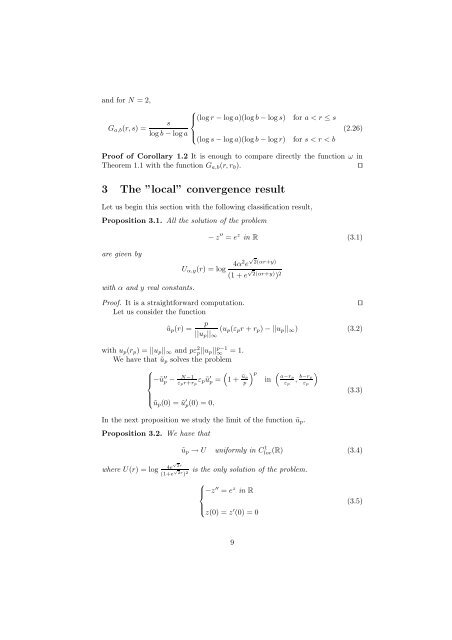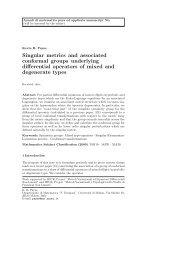Asymptotic behaviour of the Kazdan-Warner solution in the annulus ∗
Asymptotic behaviour of the Kazdan-Warner solution in the annulus ∗
Asymptotic behaviour of the Kazdan-Warner solution in the annulus ∗
You also want an ePaper? Increase the reach of your titles
YUMPU automatically turns print PDFs into web optimized ePapers that Google loves.
and for N = 2,<br />
Ga,b(r, s) =<br />
s<br />
log b − log a<br />
⎧<br />
⎪⎨ (log r − log a)(log b − log s) for a < r ≤ s<br />
⎪⎩<br />
(log s − log a)(log b − log r) for s < r < b<br />
(2.26)<br />
Pro<strong>of</strong> <strong>of</strong> Corollary 1.2 It is enough to compare directly <strong>the</strong> function ω <strong>in</strong><br />
Theorem 1.1 with <strong>the</strong> function Ga,b(r, r0). ⊓⊔<br />
3 The ”local” convergence result<br />
Let us beg<strong>in</strong> this section with <strong>the</strong> follow<strong>in</strong>g classification result,<br />
Proposition 3.1. All <strong>the</strong> <strong>solution</strong> <strong>of</strong> <strong>the</strong> problem<br />
are given by<br />
with α and y real constants.<br />
− z ′′ = e z <strong>in</strong> R (3.1)<br />
Uα,y(r) = log 4α2 e √ 2(αr+y)<br />
(1 + e √ 2(αr+y) ) 2<br />
Pro<strong>of</strong>. It is a straightforward computation. ⊓⊔<br />
Let us consider <strong>the</strong> function<br />
with up(rp) = ||up||∞ and pε 2 p<br />
p<br />
ũp(r) = (up(εpr + rp) − ||up||∞) (3.2)<br />
||up||∞<br />
p−1 ||up|| ∞ = 1.<br />
We have that ũp solves <strong>the</strong> problem<br />
⎧<br />
⎪⎨ −ũ ′′<br />
p − N−1<br />
εpr+rp εpũ ′ <br />
p = 1 + ũp<br />
p p<br />
⎪⎩<br />
ũp(0) = ũ ′ p<br />
(0) = 0,<br />
<strong>in</strong><br />
a−rp<br />
In <strong>the</strong> next proposition we study <strong>the</strong> limit <strong>of</strong> <strong>the</strong> function ũp.<br />
Proposition 3.2. We have that<br />
√<br />
2r<br />
4e<br />
where U(r) = log<br />
(1+e √ 2r ) 2<br />
εp<br />
<br />
b−rp<br />
, εp<br />
(3.3)<br />
ũp → U uniformly <strong>in</strong> C 1 loc(R) (3.4)<br />
is <strong>the</strong> only <strong>solution</strong> <strong>of</strong> <strong>the</strong> problem.<br />
⎧<br />
⎪⎨ −z ′′ = ez <strong>in</strong> R<br />
⎪⎩<br />
z(0) = z ′ (0) = 0<br />
9<br />
(3.5)








